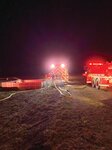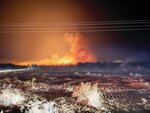

Low humidity and scorching temperatures have been a brutal combination for local firefighters, who continue to work long hours battling blazes throughout Coryell County.
Area firefighters were busy overnight responding to what the Gatesville Fire Department called "a stubborn wildfire" located south of Highway 84 between Purmela and Evant.
Caution is being urged for those involved in outdoor activities.
Via Facebook, the Gatesville Fire Department warned people to "make sure chains on trailers are not dragging. If you must weld, have a spotter and water source nearby. Don't throw smoking materials out of vehicle windows. Not all fires are started by people, but a majority of them are."
Coryell County Emergency Management will host a Firewise and community preparedness class at 5:30 p.m. Tuesday, July 26 in the Coryell County Commissioners Courtroom (the back of the county annex building across from the Gatesville post office). The event is open to the public. The session will focus on ways to help prevent fires and also how to prepare for community disasters.
Emergency Management Coordinator Bob Harrell said the event will concentrate "on what to do before, during and after a fire."
The city of Waco and many other area communities have enacted water restrictions as the level of Lake Waco plummets to near record lows. Lake Belton remains in better shape at this point, but nothing can be taken for granted with oppressive heat and drought taking their toll.
The National Weather Service has issued red flag warnings for Coryell County because of the threat of extreme weather conditions being conducive to fires. Excessive heat warnings have also been issued.
In addition to Coryell County, excessive heat warnings have also been issued for Bell, McLennan, Hamilton, Bosque, Mills, Lampasas and Hill counties.
"Extreme heat and humidity will significantly increase the potential for heat-related illnesses, particularly for those working or participating in outdoor activities," a National Weather Service Advisory stated.
The NWS encourages people to "drink plenty of fluids, stay in an air-conditioned room, stay out of the sun, and check on relatives and neighbors. Young children and pets should never be left unattended in vehicles under any circumstances.
"Take extra precautions if you work or spend time outside. When possible reschedule strenuous activities to early morning or evening. Know the signs and symptoms of heat exhaustion and heat stroke. Wear lightweight and loose-fitting clothing when possible. To reduce risk during outdoor work, the Occupational Safety and Health Administration (OSHA) recommends scheduling frequent rest breaks in shaded or air-conditioned environments. Anyone overcome by heat should be moved to a cool and shaded location. Heat stroke is an emergency. Call 9-1-1.
The Centers for Disease Control and Prevention lists the following conditions, symptoms and suggested actions:
Heat Stroke
Symptoms include:
* High body temperature (103 degrees or higher)
* Hot, red, dry or damp skin
* Fast, strong pulse
* Headache
* Dizziness
* Nausea
* Confusion
* Losing consciousness (passing out)
Suggested actions:
* Call 9-1-1 right away; heat stroke is a medical emergency
* Move the person to a cooler place
* Help lower the person's temperature with cool cloths or a cool bath
* Do not give the person anything to drink
Heat exhaustion
Symptoms:
* Heavy sweating
* Cold, pale, and clammy skin
* Fast, weak pulse
* Nausea or vomiting
* Muscle cramps
* Tiredness or weakness
* Dizziness
* Headache
* Fainting (passing out)
Suggested actions:
* Move to a cool place
* Loosen clothes
* Put cool, wet cloths on body or take cool bath
* Sip water
* Get immediate medical help if the person is throwing up, symptoms worsen or symptoms last longer than one hour.
Heat cramps
Symptoms:
* Heavy sweating during intense exercise
* Blisters on skin
Suggested actions:
* Stop physical activity and move to a cool place
* Drink water or a sports drink
* Wait for cramps to go away before resuming physical activity
* Get immediate medical help if: Cramps last longer than one hour, the person is on a low sodium diet or the person has heart problems
Sunburn
Symptoms:
* Painful, red and warm skin
* Blisters on skin
Suggested actions:
* Stay out of the sun until the sunburn heals
* Put cool cloths on sunburned areas or take a cool bath
* Put moisturizing lotion on sunburned areas
* Do not break blisters
Heat Rash
Symptoms:
* Red clusters of small blisters that look like pimples on the skin (usually on the neck, chest, groin, or elbow creases
Suggested actions:
* Stay in a cool, dry place
* Keep the rash dry
* Use powder (such as baby powder) to soothe the rash.
The NWS has also issued an alert for critical brush fire danger. High temperatures are anticipated to range between 104 and 112 degrees, with winds more than 15 miles per hour and gusty and dry fuels (vegetation) present
To help prevent wildfires, people:
* Should not toss cigarette butts on the ground
* Should not drag tow chains on the ground
* Should not park or drive over tall grass
* Should avoid leaving a campfire unattended
* Should avoid burning things
Anyone who sees wildfire should contact local fire departments and/or law enforcement, and should heed all evacuation orders from local officials.